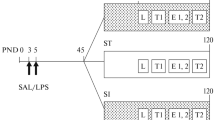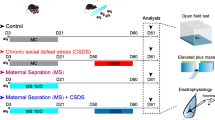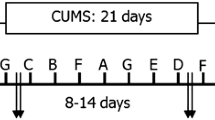Abstract
The purpose of the present study was to determine whether age would disrupt fear retention and extinction memory in rats pre-exposed to maternal separation and isolation stress; these rats are called MS rats. MS stress was induced by exposing rat pups into maternal separation followed by isolation stress from peer groups (MS) daily/6 h during stress hyporesponsive period, while controls rats that were undisturbed during this period are called NMS rats. 5, 8, 15 and 52 weeks later, these animals were exposed to classical fear conditioning test by pairing auditory stimulus (conditioned stimulus, CS+) with electric footshock. 24 h later, conditioned freezing response to CS+ was measured during fear retention, extinction and extinction recall trials. The normal ageing per se did not affect the formation of fear memory, retention and fear extinction memory. MS stress, on the other hand, disrupted fear memory at young adulthood age exhibiting increased freezing response to CS+ during retention test and reduced during fear extinction memory test when compared to NMS groups. On the other hand, rats at adolescence age exhibited reduced freezing during fear retention and enhanced freezing response to CS+ during extinction recall test. However, MS-induced changes in freezing response during fear retention and extinction tests were not seen in adulthood and 1-year-old age groups. These data demonstrate the young adulthood age is highly vulnerable to fear memory and extinction processes. The differences in freezing response to CS+ during fear conditioning from adolescence to old age, thus, appear to be related to the maturation of the limbic circuit.






Similar content being viewed by others
References
Aisa B, Elizalde N, Tordera R, Lasheras B, Del J, Río MJ, Ramírez (2009) Effects of neonatal stress on markers of synaptic plasticity in the hippocampus: implications for spatial memory. Hippocampus 19:1222–1231
Anda RF, Felitti VJ, Bremner JD, Walker JD, Whitfield C, Perry BD, Dube SR, Giles WH (2006) The enduring effects of abuse and related adverse experiences in childhood. A convergence of evidence from neurobiology and epidemiology. Eur Arch Psychiatry Clin Neurosci 256:174–186
Bale TL, Baram TZ, Brown AS, Goldstein JM, Insel TR, McCarthy MM, Nemeroff CB, Reyes TM, Simerly RB, Susser ES, Nestler EJ (2010) Early life programming and neurodevelopmental disorders. Biol Psychiatry 68:314–319
Beery AK, Kaufer D (2015) Stress, social behavior, and resilience: insights from rodents. Neurobiol Stress 1:116–127
Brown AS (2006) Prenatal infection as a risk factor for schizophrenia. Schizophr Bull 32:200–202
de Kloet ER, Joëls M, Holsboer F (2005) Stress and the brain: from adaptation to disease. Nat Rev Neurosci 6:463–475
Fareri DS, Tottenham N (2016) Effects of early life stress on amygdala and striatal development. Dev Cogn Neurosci 19:233–247
Flandreau EI, Ressler KJ, Owens MJ, Nemeroff CB (2012) Chronic overexpression of corticotropin-releasing factor from the central amygdala produces HPA axis hyperactivity and behavioral anxiety associated with gene-expression changes in the hippocampus and paraventricular nucleus of the hypothalamus. Psychoneuroendocrinology 37:27–38
Gaffey AE, Bergeman CS, Clark LA, Wirth MM (2016) Aging and the HPA axis: stress and resilience in older adults. Neurosci Biobehav Rev 68:928–945
Gee DG, Humphreys KL, Flannery J, Goff B, Telzer EH, Shapiro M, Hare TA, Bookheimer SY, Tottenham N (2013) A developmental shift from positive to negative connectivity in human amygdala-prefrontal circuitry. J Neurosci 33:4584–4593
Gonzalez A, Lovic V, Ward GR, Wainwright PE, Fleming AS (2001) Intergenerational effects of complete maternal deprivation and replacement stimulation on maternal behavior and emotionality in female rats. Dev Psychobiol 38:11–32
Grutzendler J, Kasthuri N, Gan W-B (2002) Long-term dendritic spine stability in the adult cortex. Nature 420:812–816
Gunnar MR, Quevedo KM (2008) Early care experiences and HPA axis regulation in children: a mechanism for later trauma vulnerability. Prog Brain Res 167:137–149
Gunnar MR, Brodersen L, Nachmias M, Buss K, Rigatuso J (1996) Stress reactivity and attachment security. Dev Psychobiol 29:191–204
Huttenlocher PR (1990) Morphometric study of human cerebral cortex development. Neuropsychologia 28:517–527
Jacobson SW, Bihun JT, Chiodo LM (1999) Effects of prenatal alcohol and cocaine exposure on infant cortisol levels. Dev Psychopathol 11:195–208
Jovanovic T, Nylocks KM, Gamwell KL, Smith A, Davis TA, Norrholm SD, Bradley B (2014) Development of fear acquisition and extinction in children: effects of age and anxiety. Neurobiol Learn Mem 113:135–142
Kim JH, Richardson R (2007a) A developmental dissociation of context and GABA effects on extinguished fear in rats. Behav Neurosci 121:131–139
Kim JH, Richardson R (2007b) A developmental dissociation in reinstatement of an extinguished fear response in rats. Neurobiol Learn Mem 88:48–57
Knuesel I, Chicha L, Britschgi M, Schobel SA, Bodmer M, Hellings JA, Toovey S, Prinssen EP (2014) Maternal immune activation and abnormal brain development across CNS disorders. Nat Rev Neurol 10:643–660
Koenig S, Bredehöft J, Perniss A, Fuchs F, Roth J, Rummel C (2018) Age dependent hypothalamic and pituitary responses to novel environment stress or lipopolysaccharide in rats. Front Behav Neurosci 12:55
Kosten TA, Lee HJ, Kim JJ (2006) Early life stress impairs fear conditioning in adult male and female rats. Brain Res 1087:142–150
LaBar KS, Gatenby JC, Gore JC, LeDoux JE, Phelps EA (1998) Human amygdala activation during conditioned fear acquisition and extinction: a mixed-trial fMRI study. Neuron 20:937–945
Lajud N, Roque A, Cajero M, Gutiérrez-Ospina G, Torner L (2012) Periodic maternal separation decreases hippocampal neurogenesis without affecting basal corticosterone during the stress hyporesponsive period, but alters HPA axis and coping behavior in adulthood. Psychoneuroendocrinology 37:410–420
Langton JM, Kim JH, Nicholas J, Richardson R (2007) The effect of the NMDA receptor antagonist MK-801 on the acquisition and extinction of learned fear in the developing rat. Learn Mem 14:665–668
Laxmi TR, Stork O, Pape H-C (2003) Generalisation of conditioned fear and its behavioural expression in mice. Behav Brain Res 145:89–98
LeDoux J (2003) The emotional brain, fear, and the amygdala. Cell Mol Neurobiol 23:727–738
Levine S (2001) Primary social relationships influence the development of the hypothalamic-pituitary -adrenal axis in the rat. Physiol Behav 73:255–260
Lewis M, Ramsay DS (1995) Developmental change in infants’ responses to stress. Child Dev 66:657–670
Lupien SJ, McEwen BS, Gunnar MR, Heim C (2009) Effects of stress throughout the lifespan on the brain, behaviour and cognition. Nat Rev Neurosci 10:434–445
Luu TT, Pirogovsky E, Gilbert PE (2008) Age-related changes in contextual associative learning. Neurobiol Learn Mem 89:81–85
Madruga C, Xavier LL, Achaval M, Sanvitto GL, Lucion AB (2006) Early handling, but not maternal separation, decreases emotional responses in two paradigms of fear without changes in mesolimbic dopamine. Behav Brain Res 166:241–246
Malter Cohen M, Jing D, Yang RR, Tottenham N, Lee FS, Casey BJ (2013) Early-life stress has persistent effects on amygdala function and development in mice and humans. Proc Natl Acad Sci USA 110:18274–18278
Markus EJ, Petit TL (1987) Neocortical synaptogenesis, aging, and behavior: lifespan development in the motor-sensory system of the rat. Exp Neurol 96:262–278
Masliah E, Mallory M, Hansen L, DeTeresa R, Terry RD (1993) Quantitative synaptic alterations in the human neocortex during normal aging. Neurology 43:192–197
McEwen BS (2003) Mood disorders and allostatic load. Biol Psychiatry 54:200–207
McEwen BS, Bowles NP, Gray JD, Hill MN, Hunter RG, Karatsoreos IN, Nasca C (2015) Mechanisms of stress in the brain. Nat Neurosci 18:1353–1363
Miller GE, Chen E, Parker KJ (2011) Psychological stress in childhood and susceptibility to the chronic diseases of aging: moving toward a model of behavioral and biological mechanisms. Psychol Bull 137:959–997
Nylander I, Roman E (2013) Is the rodent maternal separation model a valid and effective model for studies on the early-life impact on ethanol consumption? Psychopharmacology 229:555–569
Peters A, Morrison JH, Rosene DL, Hyman BT (1998) Feature article: are neurons lost from the primate cerebral cortex during normal aging? Cereb Cortex 8:295–300
Quintino-dos-Santos JW, Müller CJT, Bernabé CS, Rosa CA, Tufik S, Schenberg LC (2014) Evidence that the periaqueductal gray matter mediates the facilitation of panic-like reactions in neonatally-isolated adult rats. PLoS One 9:e90726
Rakic P, Bourgeois JP, Eckenhoff MF, Zecevic N, Goldman-Rakic PS (1986) Concurrent overproduction of synapses in diverse regions of the primate cerebral cortex. Science 232:232–235
Rees SL, Steiner M, Fleming AS (2006) Early deprivation, but not maternal separation, attenuates rise in corticosterone levels after exposure to a novel environment in both juvenile and adult female rats. Behav Brain Res 175:383–391
Reiss D, Wolter-Sutter A, Krezel W, Ouagazzal A-M (2007) Effects of social crowding on emotionality and expression of hippocampal nociceptin/orphanin FQ system transcripts in mice. Behav Brain Res 184:167–173
Roozendaal B (2002) Stress and memory: opposing effects of glucocorticoids on memory consolidation and memory retrieval. Neurobiol Learn Mem 78:578–595
Roozendaal B (2003) Systems mediating acute glucocorticoid effects on memory consolidation and retrieval. Prog Neuropsychopharmacol Biol Psychiatry 27:1213–1223
Sampath D, Sabitha KR, Hegde P, Jayakrishnan HR, Kutty BM, Chattarji S, Rangarajan G, Laxmi TR (2014) A study on fear memory retrieval and REM sleep in maternal separation and isolation stressed rats. Behav Brain Res 273:144–154
Schafe GE, LeDoux JE (2000) Memory consolidation of auditory pavlovian fear conditioning requires protein synthesis and protein kinase A in the amygdala. J Neurosci 20:RC96
Schmidt M, Enthoven L, Van Der Mark M, Levine S, De Kloet ER, Oitzl MS (2003) The postnatal development of the hypothalamic-pituitary-adrenal axis in the mouse. Int J Dev Neurosci 21:125–132
Seidenbecher T, Laxmi TR, Stork O, Pape H-C (2003) Amygdalar and hippocampal theta rhythm synchronization during fear memory retrieval. Science 301:846–850
Sotowright V, Bernstein M, Goldstein D, Berkowitz R (1995) The changing clinical presentation of complete molar pregnancy. Obstet Gynecol 86:775–779
Sowell ER, Thompson PM, Holmes CJ, Batth R, Jernigan TL, Toga AW (1999) Localizing age-related changes in brain structure between childhood and adolescence using statistical parametric mapping. NeuroImage 9:587–597
Sowell ER, Thompson PM, Tessner KD, Toga AW (2001) Mapping continued brain growth and gray matter density reduction in dorsal frontal cortex: inverse relationships during postadolescent brain maturation. J Neurosci 21:8819–8829
Spear LP (2000) The adolescent brain and age-related behavioral manifestations. Neurosci Biobehav Rev 24:417–463
Toda H, Boku S, Nakagawa S, Inoue T, Kato A, Takamura N, Song N, Nibuya M, Koyama T, Kusumi I (2014) Maternal separation enhances conditioned fear and decreases the mRNA levels of the neurotensin receptor 1 gene with hypermethylation of this gene in the rat amygdala. PLoS One 9:e97421
van Eden CG, Kros JM, Uylings HB (1990) The development of the rat prefrontal cortex. Its size and development of connections with thalamus, spinal cord and other cortical areas. Prog Brain Res 85:169–183
van Stegeren AH, Wolf OT, Everaerd W, Scheltens P, Barkhof F, Rombouts SARB (2007) Endogenous cortisol level interacts with noradrenergic activation in the human amygdala. Neurobiol Learn Mem 87:57–66
Yamauchi Y, Qin L-H, Nishihara M, Sawada K, Kato K, Inoue S (2005) Vulnerability of synaptic plasticity in the complexin II knockout mouse to maternal deprivation stress. Brain Res 1056:59–67
Yap CSL, Richardson R (2007) The ontogeny of fear-potentiated startle: effects of earlier-acquired fear memories. Behav Neurosci 121:1053–1062
Zoicas I, Neumann ID (2016) Maternal separation facilitates extinction of social fear in adult male mice. Behav Brain Res 297:323–328
Zuo Y, Lin A, Chang P, Gan W-B (2005) Development of long-term dendritic spine stability in diverse regions of cerebral cortex. Neuron 46:181–189
Funding
This study was funded by ICMR New Delhi and CSIR New Delhi.
Author information
Authors and Affiliations
Corresponding author
Ethics declarations
Conflict of interest
The author declares that no competing interests exist.
Rights and permissions
About this article
Cite this article
Mishra, P.K., Kutty, B.M. & Laxmi, T.R. The impact of maternal separation and isolation stress during stress hyporesponsive period on fear retention and extinction recall memory from 5-week- to 1-year-old rats. Exp Brain Res 237, 181–190 (2019). https://doi.org/10.1007/s00221-018-5411-3
Received:
Accepted:
Published:
Issue Date:
DOI: https://doi.org/10.1007/s00221-018-5411-3




